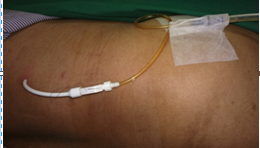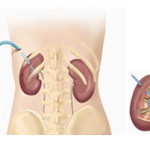- Fever more than 101oF
- Spontaneous slipping out of catheter or the securing suture (if present) has come out
- No or little urine drains into the bag over a period of 3 hours
- Severe pain at the insertion site
- Urine is stained with blood
- Urine leakage from the tube insertion site or PCN-urosac junction
CONTACT YOUR UROLOGIST IF
- Fever more than 101oF
- Spontaneous slipping out of catheter or the securing suture (if present) has come out
- No or little urine drains into the bag over a period of 3 hours
- Severe pain at the insertion site
- Urine is stained with blood
- Urine leakage from the tube insertion site or PCN-urosac junction
HAND HYGIENE
Wash hands thoroughly with soap and water, before and after handling your catheter and drainage bag.
DAILY BATH
During bath, clean the skin surrounding the catheter with soap and water without pulling the securing stitch (if present).
PLASTER APPLICATION
After taking bath, change the plaster (3” micropore) securing the catheter daily. The catheter needs to be fixed on the same side as PCN. Apply plaster at the junction of the drainage bag and PCN connector on the same side of abdomen by leaving a slack on the catheter tubing. This is to avoid direct contact of the catheter with skin, which may result in allergy/irritation. You may apply the plaster at a slightly higher or lower position everyday to prevent skin peeling.
CLOTHES
You can wear undergarments and regular dresses like pants/saree/chudidhar etc. Keep the bag secured inside your clothing by hanging it from a string tied around your waist, so as to conceal it from outside.

DRAINAGE BAG
- Never disconnect the bag from the PCN catheter
- Always empty the drainage bag when it is half full
- If urine output is to be measured, use a calibrated container
- Do not make any contact between the tip of the bag outlet & commode/container
- Always keep your bag below the level of kidney to facilitate urine drainage by gravity and to prevent the back flow of urine into the kidney
Different positions
- Sitting/Walking/Driving: Apply a string around your waist and hook the bag on it
- Sleeping on cot- Hang it beside the cot [Note: - When getting up from the lying down position, make sure the drainage bag is unhooked from the cot before getting out of the bed.]
- Sleeping on floor- Keep it on the floor near you
- If your drainage bag is a leg bag, it can be strapped on your leg (no need for string around waist)
OTHER INSTRUCTIONS
- Minimal secretions around the catheter exit site are expected
- Do not apply any dressing, ointment or powder at the catheter insertion site
- Do not pull your catheter for any reason
- If your catheter has to be kept for long time, it needs to be changed every 3 months. However, your drainage bag will need to be changed every month

